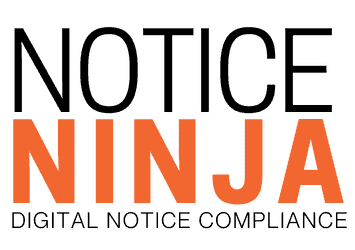Yes, NOTICENINJA is corporate tax notice compliance software that automates key workflows including notice assignments. The platform employs a rule-based system that can manage multiple level rules and ensure notices are directed to the appropriate stakeholder. As a result, you’ll never have to worry about notices being misdirected or slipping between the cracks.

Streamline & Automate Tax Notice Compliance
.png?width=1000&name=Amanda%20Reineke%20CEO%20Co-founder%20(36).png)
10 September
Why Automate Tax Compliance Management?
Are you drowning in manual tax compliance processes and finding it hard to keep up with ever-changing regulatory requirements? You're not alone. Many tax specialists and compliance teams face the same hurdles. This is where an automated compliance management system comes into play, transforming how companies handle tax compliance.
Advantages of Switching to Automated Tax Compliance
An automated compliance management system uses technology to handle tax compliance tasks, reducing human errors and speeding up processes. Here’s why it matters:
- Reduces manual work by automating routine tasks.
- Ensures accuracy by minimizing human errors.
- Keeps you up-to-date with the latest regulatory changes.
- Provides real-time monitoring to detect and address compliance gaps immediately.
NOTICENINJA offers workflows that make this transformation easier, helping tax teams focus more on strategic initiatives rather than getting bogged down in manual tasks. With automated tools, you can stay ahead of deadlines, avoid penalties, and ensure your tax processes are compliant, streamlined and standardized.

Understanding Automated Tax Compliance Management Systems
What is an Automated Compliance Management System?
An automated compliance management system uses technology to make tax compliance easier and faster. Instead of manually checking every detail, the system automates tasks like data collection, analysis, and report generation.
As a tax specialist, imagine transforming the traditional tax compliance process! Typically, that process involves stacks of paperwork and endless manual checks. By implementing automation, you can streamline workflows, reduce errors, and establish consistent standards. This shift makes meeting regulatory requirements simpler and more efficient.
Key Components:
- Compliance Workflow: Automates the flow of tasks like status-assessment and corrective action planning.
- Data Collection: Gathers data from various sources automatically.
- Data Analysis: Uses tools like AI and machine learning to analyze the collected data.
- Report Generation: Creates detailed reports for regulatory compliance.
- Task Automation: Automates routine tasks, freeing up your time for more critical activities.
Benefits of Automating Tax Compliance
Automating tax compliance offers several advantages:
1. Cost Savings: Automated systems reduce the need for manual labor, which can save your company money. According to Accenture, 93% of businesses find that AI and cloud compliance tools remove human error and automate manual tasks, making the process more cost-effective.
2. Risk Mitigation: Automated systems can proactively identify and address compliance risks. For example, they can detect if security patches are not installed correctly, which could lead to non-compliance with regulations like GDPR.
3. Real-time Monitoring: With real-time monitoring, you can instantly see your compliance status. This helps in quickly addressing any issues that arise. NOTICENINJA offers continuous monitoring of tax notices to ensure compliance in real-time.
4. Human Error Reduction: Manual processes are prone to errors. Automation minimizes these mistakes, ensuring that your compliance data is accurate and reliable.
5. Efficiency Improvement: Automated systems can compress months of work into weeks. This makes your organization certification-ready quickly and efficiently. Tools like NOTICENINJA can streamline workflows and provide in-depth assessments, enabling proactive reporting.
6. Regulatory Adherence: Keeping up with constantly changing regulations is challenging. Automated compliance management systems are updated with the latest rules, ensuring your company stays compliant. This is crucial for avoiding penalties and maintaining a good reputation.
In summary, an automated compliance management system simplifies tax compliance, saves time and money, reduces risks, and ensures you meet all regulatory requirements. With these systems, tax teams can focus more on strategic initiatives rather than getting bogged down in paperwork, data entry and other related tasks.

How to Implement an Automated Tax Compliance Management System
Steps to Automate Tax Compliance
Implementing an automated compliance management system involves several key steps:
- Identify Regulations: Start by identifying all relevant tax regulations your organization must comply with. This includes federal, state, and local tax laws. Side note: most tax practitioners state that this is the heaviest lift of their roles - keeping up with regulations!
- Assess Current Status: Conduct a thorough assessment of your current compliance status. Identify gaps and vulnerabilities in your existing processes and controls. Hint: If you are using 10, 15, or more spreadsheets, you might have some gaps.
- Define Objectives: Clearly define what you aim to achieve with automation. Objectives could include reducing manual work, improving accuracy, or ensuring real-time compliance and visibility.
- Select Tools: Choose the right compliance automation tools that fit your needs. Look for features like data collection, data analysis, and task automation.
- Map Processes: Map out your current tax compliance processes. This will help in understanding where automation can be integrated most effectively.
- Assign Roles: Assign specific roles and responsibilities to team members. Ensure everyone knows their part in the automation process.
- Develop Policies: Create or update policies to support automated compliance. Ensure these policies are clear and accessible to all team members.
- Implement Tools: Integrate the chosen tools into your existing systems. Ensure seamless data flow and compatibility with your current infrastructure. Suggestion: make sure you have 'buy-in' from all internal stakeholders to create a positive change management mindset.
Key Features to Look For
When selecting an automated compliance management system, consider the following features:
- Integration Features: The system should easily integrate with your existing databases and software and even better if the solution has an open API.
- Data Aggregation: It should gather and consolidate data from various sources, including regulations, policies, and internal systems. A repository is key.
- Workflow Management: Facilitates workflow processes related to compliance activities such as approvals, document management, and audit trails.
- Risk Assessment: Conducts risk assessments and offers strategies to mitigate identified compliance risks.
- Reporting: Generates comprehensive reports and dashboards to visualize compliance status, risks, and performance metrics.
- Task Automation: Automates manual processes like self-assessments, monitoring controls, testing, and generating compliance-related reports.
- Alerts and Notifications: Issues alerts and notifications for potential compliance breaches, deadlines to enable prompt action.
- Documentation: Maintains detailed records for audits and compliance purposes, ensuring transparency and accountability.
- Scalability: Offers scalability and customization to grow with your organization’s needs.
By focusing on these steps and features, you can streamline your tax compliance processes, reduce risks, and ensure regulatory adherence.
Seizing Strategic Advantage with Automated Compliance
Implementing an automated compliance management system like NOTICENINJA can revolutionize how your tax team handles compliance. By automating manual processes, you can achieve significant cost savings, reduce human error, and ensure regulatory adherence.
With NOTICENINJA, you gain:
- Efficiency: Automated processes free up time for your team to focus on strategic activities.
- Risk Management: Continuous monitoring and real-time alerts help you stay ahead of potential compliance issues.
- Cost Savings: Reducing manual tasks and errors translates to lower operational costs.
- Regulatory Adherence: Stay compliant with ever-changing tax regulations effortlessly.
Incorporating an automated system into your workflow is not just a smart choice; it's a strategic investment. It simplifies complex tasks, provides real-time insights, and ensures you are always audit-ready.
Enhance Your Compliance Strategy with NOTICENINJA
Incorporating NOTICENINJA into your tax compliance strategy revolutionizes the management of IRS notices and overall compliance tasks. As a digital assistant, NOTICENINJA extends your team's capabilities, allowing you to handle tax notices with unprecedented efficiency and precision.
Our platform streamlines the entire notice management process—from immediate notification and sorting to responding effectively within IRS deadlines. With features like OCR Scan-to-Capture and interactive dashboards, NOTICENINJA ensures that handling large volumes of tax notices becomes a seamless part of your daily operations, significantly reducing the risk of costly errors.
Moreover, NOTICENINJA’s built-in templates and detailed record-keeping enhance your ability to maintain timely and accurate communications with the IRS, reinforcing your compliance strategy.
Ready to elevate your tax compliance strategy? Discover how NOTICENINJA can streamline your compliance workflows and boost accuracy. Schedule your free demo today and take the first step towards effortless tax compliance!
